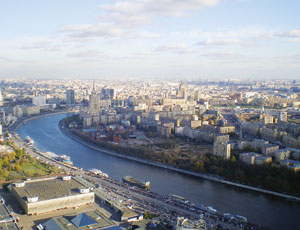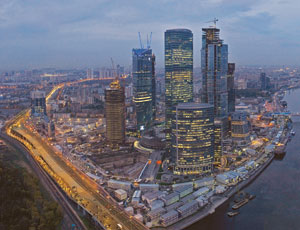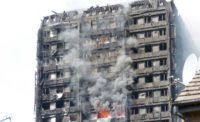Until recently, no buildings in Moscow surpassed the 240-meter Moscow State University—the tallest of the city’s “Seven Sisters” towers built at sites throughout the city during Stalin’s era. But a few years ago, Russia’s new wealth from natural resources started an upward rush. Before the global economic crisis hit, plans were moving forward for 4.6 million sq m of high-rise development by 2012. But with only two buildings complete and 11 under way, developers are raising eyebrows by putting some jobs on hold. Still, Moscow remains Europe’s high-rise hot spot.

There is “a bit of the Wild West” in Russian real estate, says David Klondar, the local general director of U.K.-based engineering firm Waterman International. “Developers want the flashiest, biggest buildings but they also want them as cheaply as possible,” he says.
The Russians newfound thirst for high-rises, combined with a lack of experience in design and construction, has attracted international firms. Waterman is among western firms drawn to Russia to fill an engineering gap left by the demise of Communism. Apart from the massive steel-framed, stone-clad Seven Sisters built around 1950, Moscow had “no proper tall buildings,” says Stanislav Nikolaev, director of the TSNIIEP Zhilisha design institute. “We have to design tall buildings almost from scratch,” he adds. “We have to go to world experience.”
In Communist days, “all good [design] initiatives were punished,” says Lev Rakovsky, development director of the developer Eurasia Investment and Industrial Group. A nationwide preponderance of buildings designed to templates is one legacy of the Soviet era. “Now we are having a good time,” he adds.
On the Moscow River’s north bank, next to the third ring road, a cluster of towers mark the Russian capital’s new high-rise hub, Moscow City. The 365-m Federation Tower, the building on deck to grab the title of Europe’s tallest from Frankfurt’s 259-m-tall Commerzbank, is rising on one of over 20 lots in the brownfield area.
Other sites are being readied across the city, such as the 29-building Park City on a site further down the river, master planned by Kohn Pedersen Fox Associates (International) P.A., London. Along outer beltways, the city-owned company OAO New Ring of Moscow has identified 58 brownfield sites, each capable of handling several developments, most of which would be high-rises. Cleanup work has begun at 14 while mitigation and site preparation are complete at 38, says Alexey Chaikin, deputy director.
To serve demand, Waterman was one of the first international design firms to set up in Moscow, in the early 1990s, says Klondar. It now has over 50 staff focusing on building structures and services. The firm has reported booking Russian orders for 1.5 million sq m of space this year, but demand is now falling off, says local director Snezana Stojkovich.
In 2002, at the boom’s start, New York City-based structural engineering firm Thornton Tomasetti Inc. went scouting for work.√ “We were selling high-rise experience,” says Leonid Zborovsky, TT principal. The firm is working on two of the city’s tallest towers, among others.
Arup Group, London, opened a Moscow office nine years ago, before the ruble crisis erupted. “Clients were mothballing projects, people were leaving and our competition were closing offices,” says Alan Hart, Arup’s local director. Arup stuck it out. By and large, foreign consultants are trying to work from afar, which is difficult, he adds.
The locals have not been idle. Russian firms are gaining experience and are increasingly able to handle sophisticated projects, says Sergey Lakhman, general director of the local Gorproject. In six years, he has grown the design firm from 25 to 170 staff, mainly in Moscow, he says.
Internationals are rewarded by work but they also face language barriers and smothering bureaucracy. The first wave operated in a market devoid of modern codes for high-rise design. Then, “the government’s decision was that each building would have its [own] specification,” says Zborovsky.
Federation Tower “was used...to develop codes, especially for fire,” adds Matthias Lassen, project leader for NPS Tchoban Voss GbR Architekten BDA, Berlin, Federation Tower’s German co-architect. For many years, Moscow’s height limit was capped at 80 m.
Towers also meant using construction materials of strength grades and quality new to Russia. For example, securing 80-mpa concrete for Federation Tower was initially a struggle, says Olga Karpova, a department director with the developer Mirax Group. In the taller of Federation’s two buildings, 90-mpa concrete is being used.
Investors in what will be one of Europe’s tallest steel frames, Moscow City’s 72-story Techninvest Lot 12, had to go abroad for materials, says Rakovsky. In Russia, “it was impossible to get high-strength steel with [needed] plate thickness of over 50 mm,” he adds.
The supply chain is long and tortuous. Basic sections are being delivered from Luxembourg to Antwerp. From there, the main contractor, Istanbul-based Enka Construction & Ind. Inc., ships the steel to its fabrication yard near Bursa, Turkey.
Completed fabrications are taken to Russia across the Black Sea and by barges on rivers and waterways to Moscow. The building is due for topping out in 2010.
Russians also need aid getting from design to construction. Locally, there is “no expertise” for high-rise, says Glenn Collins, Russia country manager for project manager Turner International LLC. On Turner’s Federation Tower job, “investors needed the comfort of working with international firms,” he says.
Once on site, local notions of safety can startle foreign visitors. Even in Moscow City, standards are like “those of a third-world country,” says one western manager. Adds another, “I’ve seen guys wearing metal chains connected to the side of the building.”
Seven deaths have been formally reported among Chinese workers at Federation Tower, though more are suspected. “We are trying to follow it but there are more than 20 contractors and many subcontractors,” says Utku Baris Bıçak, Turner’s quality and safety manager.
Lack of transparency makes record keeping difficult, but “it’s becoming better,” he says. “The clients are starting to understand the value of safety,” agrees Neil Carson, senior construction manager of Bovis Lend Lease International Ltd., manager of the Techinvest building now under way.
In Russia, green building has not yet taken hold. That “will take a while,” says Lassen. “Environmental issues have not grown in the minds of the people yet and also energy prices [in Russia] are low,” he says. “Of course it would be better to have more understanding on the client side.”
New York City-based architect Swanke Hayden Connell International Ltd. has negotiated the design contract for one of the outer-ring developments. It would have three residential towers, the tallest planned at 45 stories. “They want to build a [cogeneration] plant for this project,” says Altan Gürsel, a principal at SHCI. Designed to the silver standard of the LEED green-building rating system, the project is in Moscow’s emerging green building vanguard.
Another sustainable tower would be Moscow City’s planned 600-m Russia Tower, designed by Foster and Partners, London, as Europe’s tallest and the world’s tallest naturally ventilated building. Recently postponed, the skyscraper’s fate is uncertain.
That’s true for more than one project, thanks to a credit crunch. The 350,000-sq-m Moscow City government tower is also stalled. And “private jobs keep stopping left and right,” says a senior international executive. “Some of the jobs stopped in the middle of design,” he adds.
“Projects under construction seem to go ahead and probably will not be stopped,” says Lakhman. It’s different for planned development. Construction manager Collins adds, “I’ve had three projects mothballed.”
To concentrate on jobs under way, Mirax has suspended new projects or those under design, confirms Karpova. But few doubt that Russia’s demand for high-quality space remains vast. Talk of market collapse is “over-exaggerated,” says Lassen, who believes midterm prospects remain good.












Post a comment to this article
Report Abusive Comment